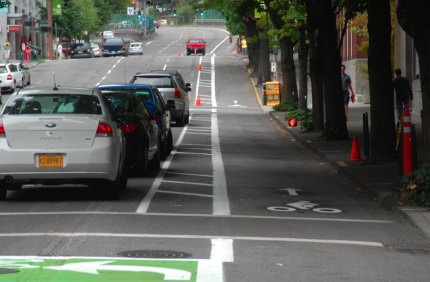
(Photos © J. Maus)
Making good on a promise to install a “high-profile” cycle track, Mayor Sam Adams will join Portland State University President Wim Wiewel, BTA executive director Scott Bricker and City of Portland staff to formally introduce a new kind of bikeway today.
The cycle track runs from SW Clay to SW Jackson and the project cost the City around $80,000. People riding bikes on that stretch will now be separated from moving motor vehicle traffic by parked cars and a 3-foot, striped “buffer-zone” will protect them from car doors.
PBOT was able to open up the 7-foot traffic lane specifically for bicycles on SW Broadway after an analysis of motor vehicle traffic volume showed three standard travel lanes were not needed.
This morning, City traffic engineer Rob Burchfield and engineer Scott Batson were on the street as crews put on finishing touches to the new pavement markings.
In addition to the cycle track markings, people on bikes will also notice a brand new marking — a special bike box installed to aid in what are known as “Copenhagen lefts”. The green boxes (similar to existing bike boxes) are to facilitate left turns out of the cycle track (see photo at right). Burchfield said these are the first boxes being used in this manner in North America.
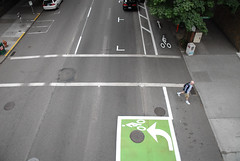
to facilitate left turns out of the
cycle track) as seen from above.
Burchfield said the new boxes are a big step for Portland, but added that he feels they will be helpful and safe. “People in the boxes will be shielded from motor vehicle traffic by the parked cars on each side.”
Unfortunately, even though the big opening ceremony takes place today at 2:00pm, the cycle track is still not completely ready for prime-time. A PSU construction project between SW Market and Mill is taking over the cycle track’s space and won’t be cleared out until the end of this week. Other bits and pieces of the new cycle track markings aren’t quite finished yet because of the I-405 re-paving project and other PSU construction.
But for several blocks, Portlanders will be able to try out a new type of bikeway. It will take some getting used to riding alongside the curb with parked cars to your left, but ultimately, PBOT is betting that the feeling is much more comfortable (and ultimately safe) for bike traffic. PBOT is doing this as a demonstration project with hopes of doing similar treatments to other streets.
PBOT has created a new brochure (similar to what they created for the bike box unveiling) to educate people about the cycle track. They’ll be handing them out at today’s event and to passersby along SW Broadway. Here are some scans from it:
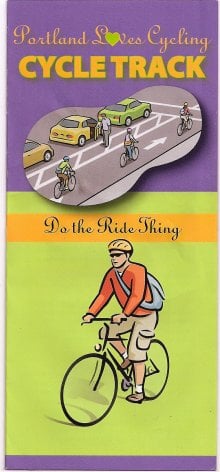
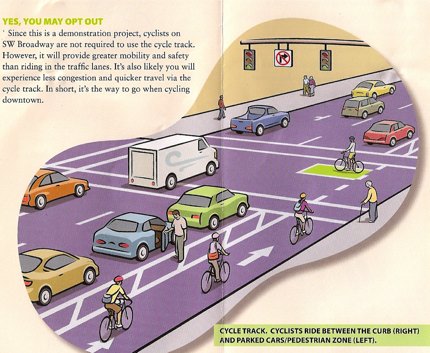
The brochure addresses several issues:
- “Making Left Turns: “Cross through the intersection and stop in the bike space designated for cyclists turning left.”
- “Getting Off Track: To avoid collisions… cyclists should leave the cycle track only at street intersections…”
- “TriMet Bus Interaction: During morning peak hours, TriMet will continue bus service at two stops along the cycle track… buses still pull to the curb, across the cycle track, during these times…”
- “Yes, You May Opt Out: Since this is a demonstration project, cyclists on SW Broadway are not required to use the cycle track…”
This morning, Burchfield seemed a bit nervous. “I am” he said when I pointed it out, “I was up at 3 AM, worried about the transitions and wanting to make sure no one parked incorrectly.”
— Learn more about this project on the City’s website. See more images in the photo gallery.



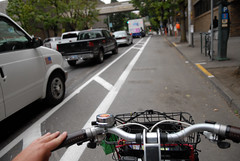
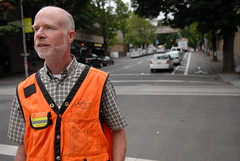
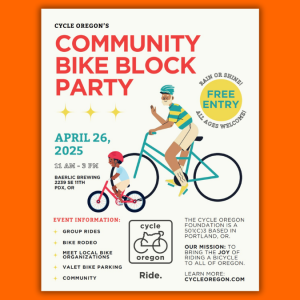
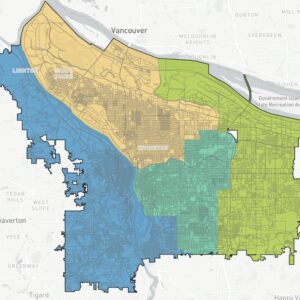
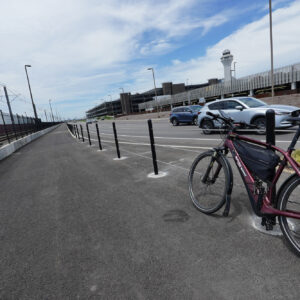
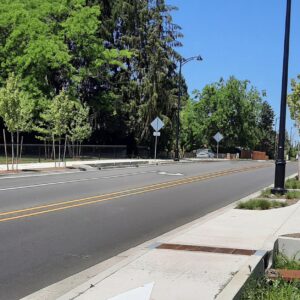
Thanks for reading.
BikePortland has served this community with independent community journalism since 2005. We rely on subscriptions from readers like you to survive. Your financial support is vital in keeping this valuable resource alive and well.
Please subscribe today to strengthen and expand our work.
i like the way they handled the left turns. the bus stops aren’t ideal, but you can’t win them all, especially since those stops are super busy.
This is great news! Broadway coffee is right across the street there from Shatuck Hall, between Hall and College! I guess I can get my coffee before I head out of downtown now on my bike!
I think this is a real opportunity to unite small businesses by a common, more humane transportation mode that will be sure to help out our local business in trying times! Great work PBOT!
i think the major thing to watch for is right hooks by cars. Bikes are much less visible through this design. Hopefully there are no accidents.
I rode it this morning. I ride just about anywhere, panting up hills with roaring cars beside me, no problem. But I LOVED this. It is so quiet and calm over there alongside the trees, against the curb.
Sure there will now be bike-ped conflicts to negotiate, but I’ll take those over freeway-bound college students in big cars any day. A little eye-contact and speed adjustment ought to make it all pretty smooth.
The BTA’s overall goals in proposing and supporting this project, and in pushing many other projects with the City of Portland, is to attract people to bicycling in the city who aren’t doing it today. By making it more comfortable and appealing, we will get more people doing it, and that will make all of us safer.
Nice work, City! Keep it up!
The illustration looks a bit confusing, is there really a green island in the middle of the traffic lane where bikes stop? The light is green so either he’s running the light or it looks pretty damn sketchy.
PS – You know the City will get phone calls from people who think this is a zero-sum game – that if it’s good for biking, it must be bad for car driving. That is, of course, not the case here.
But please help counteract it by emailing the Mayor’s office and supporting this action. They need to hear from us.
p.s. someone forgot a tag.
Thanks, fixed it. That’s an em tag, for any amateur html-closers out there. — Elly
One quick question: are the parking spaces still payed parking spots? And for how long? It would seem to me if they were long term it would maintain a pleasant experience for that stretch of the cycle track all day, without the potential for any disruptions of vehicles passing in the cycle track right of way.
Also, if those were faculty parking spots for PSU, I could see PSU really taking ownership of them, perhaps even taking over the maintenance of them if PBOT was in a bind. Although there will always be the prospect of buses crossing the track though.
I could even see eventually that that lane of parked cars could become a bus lane, but with cleaner and quieter buses to maintain the pleasant biking experience. This way, the cycle track wouldn’t have to be impeded by the bus at all. Thoughts?
great work! everyone can learn from this design..
#3 I believe there are no right turns on this section of road.
Paul…there are no rights turns on this section..its all PSU campus, no through streets.
paul #3: There’s only one legal right turn between SW Clay and SW Jackson (at SW College), that’s probably the reason why this section of road was chosen for a cycle track. There’s little danger of getting right hooked here.
#3 and #10. There are no turns to the right because PSU’s campus is reserved for pedestrians and bikes from SW Mill down south to SW Jackson.
How does this avoid right hooks from cars?
The brochure says “it will provide greater…safety than riding in the traffic lanes.” I’m not convinced of that! The illustrations make it look like there will be less visibility for car drivers to see bicyclists around parked cars when turning right.
@ disastronaut:
“The illustration looks a bit confusing, is there really a green island in the middle of the traffic lane where bikes stop? The light is green so either he’s running the light or it looks pretty damn sketchy.”
I don’t really see what’s confusing. The cyclist wants to turn left. To do this, she rides straight through the intersection while the lights are green and positions herself in the green box. Once the lights for straight-going traffic have turned red, she can cross the intersection into the left street. The box is not in a traffic lane but in the lane with parked cars (note the guy exiting his car in that lane).
I’m curious to see how this design is going to work. I see potential conflicts with people turning into the box and left-hooking other, faster cyclists. In Germany this type of turn-box is usually located to the right of a bike lane.
Disatronaut (#5), the bike in the illustration that is in the bike box, is not in a lane of traffic, but in a “lane” of parked cars.
Disastronaut #5 – the green box is in line with the parking lane. Note the gentleman entering a car in the previous block.
What about driveway/alleyways? Are there traffic controls at those intersections as well? I can just see cars pulling out and blocking the cycle path whilst they wait for their chance to pull out into the lane.
This design can be great, as long as there are no pull-outs to contend with. Traffic engineers like sexy designs and like to just throw them around without thinking about the potential hazards… like here in Long Beach, CA
Dominic #15, I wish I thought our problem here in Portland was that traffic engineers threw around sexy designs with abandon! That’s not the case at all.
Instead, like most places in the country, our traffic engineers have often been extremely conservative, following national standards and guidelines that don’t create world-class bicycling conditions.
This facility is a good example, I think, of engineers leading the way with a thoughtful test pilot project, based on tested European facilities and engineering judgment, that can be refined in future projects. I look forward to hearing the reports, especially from families with kids heading to the farmer’s market.
Very cool! I’d think if this is successful, you could move the bus stop INTO the parked car lane and avoid any potential bike/bus conflict. You could have a little island with a couple benches and maybe a tree or two.
As pointed out earlier, the new conflict will be between peds and bikes as peds use the bike lane to position themselves to cross Broadway. I wonder if there will be any reminders to peds at crosswalks and between blocks to stay out of the bike lane and watch for bikes.
Unfortunately, this sort of caution signage is not utilized much in Portland. Painting the entire thing green would be amazing, but I understand it raises costs.
While biking in I noticed how much calmer the experience was compared to the old narrow lane. The construction in this area is still an issue though, but that is common around PSU.
I hope PDOT smooths out the pavement where the old parking delineations were and adds some ‘no turn on red’ signs on College and Mill.
This project will be interesting to watch mature.
@ #16, #17,
Gotcha. I was seeing a lane of traffic instead of parked cars. Need to retrain my eyes.
Erinne #14: See comment numbers 10, 11, 12 and 13 to understand why there won’t be a problem with right hooks.
What, exactly, will this demonstrate: that if you give extra room to cyclists on a short, straight stretch of roadway with no prospect of vehicular cross traffic, it will make cycling straight ahead easier? Perhaps it will demonstrate that if you confine cyclists behind a row of parked cars on the right hand side of multi-lane one way streets, it will make turning left into an annoying multi-stage process.
So when can we expect a demonstration project that will demonstrate how these types of facilities work on the 99.9% of metro area streets where cars can actually make right turns?
I’m also curious as to how this allingment will effect the pick up / drop off issue for PSU students during the school term. Has this been addressed?
This looks like a much better implementation than the new one on Holgate. Why did that not get the same parking design?
Finally something that should make motorists and cyclists happy at the same time.
Babygorilla #24
The methodology that they (PDOT) are employing is just about perfect. They invest a very small amount of money to test a possible option and collect data on how well it works before a larger investment. Sure the absence of right turns makes this a bit cleaner than a typical street in the grid but:
a) There are other streets that abut rivers and parks where no right turns are possible.
b) Maybe this is setting the stage to build a road without the possibility of a right hook. If there were some “No right turn – bicycles excepted” signs then the road would function like this test case.
It is clearly described as a test. If/when the results are validated, then it makes sense to build some longer routes that link our city together. What I find promising is that this test implies quite loudly that we’re to expect additional investment down the road, ha.
Congrats to PBoT (and PSU). I will test ride it this weekend.
Portland took a similar approach to Seattle’s Alki buffered bike lane (street grade bike track) demo by finding a nice (but rare) arterial with bike traffic a little right turning traffic.
I rode this section at 6AM today, which is usually a very tranquil time anyway. The PBOT crew were still making some final touches and a news crew was filming.
This is a wonderful experiment from which we can learn. I like the width and the built in buffer on the left for (avoiding) opening car doors. You really do feel like you are riding in your own protected bike path.
I worry about the parallel parking skills of most drivers (translation- will they overshoot into the bike lane since their is no curb to stop them?) and the buses, which will have to swing across the parking lane and buffer to get to the curb. In many years of making this commute, most Tri-Met drivers have been incredibly aware of and sensitive to cyclists. But a small number have been quite aggressive.
And although there are in theory no right turns, service and delivery vehicles do make right turns to access the campus buildings. And at times they are backing in, which may prove to be a real safety issue.
Kudos to city traffic engineers Rob Burchfield and Scott Batson, the Mayor’s Office and the BTA for making this happen. It may not prove to be the best solution but we will now get to find out.
I have commuted on this stretch of Broadway to OHSU for almost 10 years and I have never had a problem. I am curious to see how this cycle track will change things.
My first impressions are that there is still some confusion with the signage but that will probably change once all the construction is complete. Secondly, the road is still grooved from where the old lines were. Hopefully this will also get fixed. Lastly, I am curious as to how pedestrian traffic will play a role once PSU is back in full swing after the summer break, and also how cars and busses dropping off students will adapt to the change.
Overall, it is great to see the city take on something like this and hopefully it will improve this relatively safe stretch of my commute.
Eugene has had this concept in effect along the UO campus for 20+ years with the exception that there is a contraflow lane (bike goes in opposite direction of roadway travel) on one side. It has been very effective.
This is horrible. I realize this is just an experiment, so I’ll spare you all the outrage. For the type of vehicular cyclist I am, this diminishes my access to the public right-of-way, chokes motorist traffic, is bad PR for all cyclists, and most of all lends credence to the notion that it is okay to spend public money on placating irrational fears.
What is gained accommodating noobs and weaklings if you alienate the seasoned vets(If the shoe fits. If not, then why the look?)? Why are noobs afforded such high levels of service, while those who have sacrificed get spit in the eye? Super uncool this.
Sorry folks, but I hope there is some good ol’ fashion ignorant Portland outrage over this, I really do. The whole DT remodel is too anti-car. Some, okay, it’s the times we live in, but adding to congestion down here like this is going to seriously enrage some transportation types.
At least it’s on the right (not left) side of the road, right where people expect such things, unlike the ones in New York City.
Still I’ll give NYC credit for designing left turn bays for cars the just about eliminate any possibility of a left hook. Just invert that design and it would eliminate right hooks in this application.
Oh and Vance,
I want to see Portland get up to 20%+ mode share. When I ride around here in New Jersey I have to ride vehicular style because we have no on-road facilities. I agree with Vehicular Cycling principles when facilities don’t exist but as a former student of Prof. John Pucher here at Rutgers, I can tell you VC just can not get your city up to those Copenhagen / Amsterdam types of mode share numbers but facilities like this can.
Also does the law in Oregon prevent you from riding in the lane when a facility like this exists? I know other states have laws like this.
I’m wondering how buses and bikes will interact with this setup– seems like a bus would need a large gap to pull all the way to the curb, and car parking would be in the way.
and Vance (#29)– that’s the most ridiculous criticism I’ve ever heard. sounds like you want PDOT to erect obstacles to safe cycling. if you want to see more people using bicycles, you’re going to have make it attractive to those who don’t want a stressful, unpleasant experience.
as the brochure states, you’re free to opt out.
As someone who rides this stretch of road a lot, I welcome the experiment. The previous bike lane was a recipe for being doored. I often had to quickly stop or turn into the adjacent car lane to avoid doors being opened.
The biggest challenge, IMHO, will be with delivery trucks parking in the cycle track. If you ride this stretch during the morning rush there are almost always trucks blocking the bike lane so that they can make their deliveries. The same can be said of people dropping off students at PSU. The lack of loading zones will be a challenge. It will also be interesting to see how this works with all the pedestrians while the university is in session.
I heard from the business owner of Broadway Coffee, just right across the street from the main photo of this post, that the current shed-like building in front of Shattuck Hal,l which is now an office for public safety at PSU, is slated to become a park at some point.
At the light at Jackson, at the top of the hill, you have the option of turning right into the parking lot next to the tennis courts. On the right hand side there are some parking spots for some patrol cars from public safety that I would assume would be moving with the removal of the shed-building.
To keep this comment short, I think this might be a candidate for a loading zone in the future. In addition, I believe the tennis courts and that adjacent parking lot are on their way out as PSU plans to develop another dormitory for its students, which is another win for PSU students who intend to bike to and from their residences on Broadway.
The way I see it, this cycle track is more to do with providing a safe route out of down town, leaving PSU, than the other way around. Therefore I don’t think it’s going to be used to get people to the Farmer’s market too often, but it will alert drivers to the somewhat precarious connection past Jackson when bikers seem to lose a dedicated lane crossing I-405.
“Eugene has had this concept in effect along the UO campus for 20+ years with the exception that there is a contraflow lane (bike goes in opposite direction of roadway travel) on one side. It has been very effective.”
To add to KS’s comments (#31), I’d like to add that the cycle track in Eugene exists for two blocks on 13th Avenue, beginning at the end of campus.
The street is relatively lower traffic than of Broadway’s, but included in the design are mode-barriers (concrete blocks) between the parked cars and the cycle track. Curiously enough, on the next block after stopping at a light, there is nothing separating bikes from oncoming cars but a solid yellow line.
I think the fact that this project, with cyclists going the same way for a series of blocks, instead of straight against traffic such as is the case with the cycle track here in Eugene, will work in PBOT’s favor as it seeks to find a safe design to replicate across Portland.
To my knowledge there hasn’t been a real problem with injuries or crashes on that second block of the cycle track, but then again I am just one of many cyclists, not a professional with the statistics.
Jersey Andy #33 asked: “does the law in Oregon prevent you from riding in the lane when a facility like this exists?”
from the Cycle Track brochure:
“Yes, You May Opt Out: Since this is a demonstration project, cyclists on SW Broadway are not required to use the cycle track…”
This looks great.
I see they painted stripes on both sides of the buffer zone, which looks clear and appropriate.
I both drove and rode on the new SE Holgate last week … I still feel strongly that we need the “3rd stripe” along the hash marks for clarity. Ambiguity increases risk.
I wonder why they painted it on SW Broadway, and not SE Holgate?
andy 34 yes there is a mandatory sidepath law in Oregon. max 35 the only reason you can opt out now is because this particular facility is “experimental.” bikie 39 once they decide it is no longer experimental, the mandatory sidepath law will apply. gorilla 24 it is just possible the people at PBoT have enough sense to see that a cycletrack will not work everywhere. maybe they will also figure out that a bike lane should not be solid striped all the way to the intersection. in an environment with right turns, the cyclist should be in the traffic lane.
The buses are the fatal flaw here. That’s why NYC’s cycle tracks are on the left side of the one-way street instead of on the right side. They absolutely should have done the same thing here.
Many thanks to Mayor Adams and the PBOT staff (in particular, traffic engineer Rob Burchfield) for bringing this innovative and exciting new design to the front door of Portland State. We are very proud to have the opportunity to play a part in pioneering this design and helping evaluate it for future applications throughout the city.
Constructive criticism of this project is vital, so please ride come ride the cycle track and share your impressions with PBOT, the mayor’s office, and PSU Transportation. We’re especially keen to hear responses from PSU students and staff, so don’t be shy.
FYI: Buses
The only TriMet bus that now stops on this stretch of Broadway is the #68, which only operates in this area during peak AM hours. It only stops there between the hours of 6am and 9am, Mon – Fri.
TriMet felt it was important that these stops remain on Broadway after all the other buses moved back to the transit mall on 5th and 6th avenues.
I’ve ridden this stretch en route to OHSU for the last 15 years and rode the cycletrack this morning. I appreciate the design and all, but it seems fairly unnecessary; the road is very quiet, low-traffic, and aside from leap-frogging buses, is free from significant hazards.
But I’m not complaining; it’s an interesting experiment and I would love to see the idea implemented elsewhere.
I still worry about the right hook issue, though.
32 – You’ll never get what you want by acting like an elitist bike martyr. Want to know what’s really bad for cyclist PR? The macho holier-than-thou types who look down their nose at anyone not wrapped in spandex. Unsurprisingly, it’s these same riders who zoom about recklessly with disregard to the law and general human decency. Yes, I’m a seasoned veteran pedestrian who is tired of nearly being run down on the sidewalk, in crosswalks, on the MAX platform, etc.
But I don’t go on the internet and pitch a tantrum like an emotional weakling and tell everyone how much better I am than them. Having been to other countries and seen these lanes work very well I know your arguments are baseless whining. The only reason you oppose this is you believe nobody has the right to tell you where to bike, and you might as well drop that attitude since it benefits nobody.
CPF, you make some interesting points about transportation infrastructure, but please respect this forum and do not present your ideas in the form of a personal attack. Thanks — Elly
Bill (#40) wrote – “I both drove and rode on the new SE Holgate last week … I still feel strongly that we need the “3rd stripe” along the hash marks for clarity… I wonder why they painted it on SW Broadway, and not SE Holgate?”
Bill, a perspicacious question, that – it looks like we’ll be adding one on Holgate. We (various PBoT bike people /traffic engineers) weren’t sure if it was needed (unlike Broadway, where we wanted a clear demarcation between the pedestrian zone and the cycle track)– but seeing the project on the ground & listening to feedback we’re pretty much convinced that a longitudinal line between the bike lane and the buffer area would be helpful to define the space a bit better.
I rode it and about had an orgasm. I mean, there was never really any traffic on this stretch of Broadway before at 7:30 in the morning and there isn’t any now! Wow, what a great way to spend $88,000. Now if I can just get there without getting doored or run over between Burnside and Clay it will really be wonderful. Are we really trying to make downtown safe for children to ride bicycles? Because any adult could easily ride this stretch of Broadway without this. The backlash from the anti-bike crowd is not worth this little project. It will just get harder to get funds for more worthwhile projects.
Coming from an occasional cyclist this looks very promising. As a PSU Alumni it also looks like a great spot to test it out! Hopefully this program works out well and we start to see more of these cycle tracks in Portland. Thanks Mayor Adams and PBOT.
I usually do not ride this section of Broadway. But, today I happened to have an errand downtown after work, so I decided to take the new cycle track.
Before I got to the cycle track, I had to pass through the hotel zone. Today I lucked out and there wasn’t a motor vehicle parked in the bike lane that would have required me to go into the car lane.
Next thing I noted was the mini-van broken down in the cycle track. I asked the driver if she was aware that they (meaning PBOT) wanted her to park in the parking spots in the middle of the street. The driver said that her transmission was broken and she couldn’t move elsewhere. I’m not 100% sure she understood my question, and I didn’t feel like drawing a diagram for her. So I kept going.
There was a news crew further south that had parked their satellite van in a parking spot to the left of the cycle track. They were using the buffer area for storage of their equipment. I could easily envision a delivery van using the buffer, or the cycle track itself, for unloading cargo.
The cycle track might be wide enough for the street sweeper to come through in about 2 months and sweep up the leaves, but when I see that I’ll believe it.
I agree with the above posts that say that once this project is not an experiment, it will be effectively mandatory. That’s especially true given existing Oregon law, and the Portland Police Department’s and Portland traffic court’s creative interpretation thereof. I use so-called Copenhagen or 2 stage left turns sometimes, but I don’t like effectively being prohibited from making a vehicular left turn.
Overall, this project is not worth $80,000. So this one section of Broadway feels safer. So what? A bicyclist is going to have to get to and from this part of Broadway, past the cars parked in front of the hotels, past the other cars broken down in the bike lane, and past the delivery vans. A bicyclist who has sufficient road skills to get to the cycle track doesn’t need the questionable feeling of safety of the cycle track. And a bicyclist who would only feel comfortable riding on a cycle track could not comfortably get to the cycle track and has nowhere to go once the cycle track ends.
I would rather have seen the $80,000 go toward projects that support people who are already bicycling than trying to lure people who maybe might bicycle but only if they feel absolutely safe. I think that group will always have an excuse for not riding. There will never be sufficient funds in the budget to create an end-to-end route for them to feel safe. Even if there was, then they still wouldn’t ride because it rains or gets dark sometimes.
Projects I would have liked to have seen funded instead are pro-active pruning of the vegetation that intrudes onto the bike lanes. In a platinum level bicycle friendly community, that should get taken care of without having to call it in. Or make the storm sewer grates on Capitol through Hillsdale, and on Beaverton Hillsdale Highway, level with the rest of the pavement. Bigger projects that I’d like this funding to have gone toward are filling the gaps in the bike lanes on Barbur south of Capitol, or even fixing crash corner (also known as Beaverton-Hillsdale/Oleson/Scholls intersection.) Yes, crash corner is outside the Portland city limits but only by about 6 blocks.